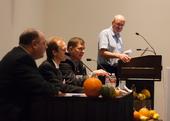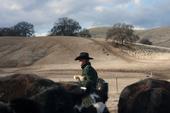- Author: Brad Hooker

The gauge reads 105 degrees in California's state capital as this article is being drafted. The four-year drought has baked itself into the landscape, with dead lawns crunching under feet and trees wilting under the heat, and has so far stolen a year's worth of precipitation. Deprived of moisture, the state has lost to wildfires three times the acreage of an average year. The once green valleys are now murky fishbowls of haze.
The total cost to the state, according to a new report released Tuesday by the
- Author: Brad Hooker

California's severe drought is entering a fourth year. With that, scientists met with ranchers to give background and gain feedback on a key climate indicator: the U.S. Drought Monitor.
The November 7 workshop held at the University of California, Davis, and webcast to 15 satellite locations across the state posed questions to a panel of experts who help publish the weekly analysis. UC Davis researchers also discussed new findings from in-depth rancher interviews along with strategies for maintaining the nutrition of cattle during the water shortage.
Read the full article at the UC Davis...
- Author: Brad Hooker

One image has had every Californian cringing this year: the U.S. Drought Monitor map. Like a slice of molding bread, the drought began in the middle, grew darker and moved outward in concentric rings that gradually devoured the state. The reaction was shock. Yet what does such a large map mean to individual ranching operations? Where does this information come from? And how does it affect research and policy? With forecasts shaping up for yet another drought this fall and winter, serious ramifications may be coming for ranchers.
These concerns and more are being discussed at an upcoming meeting called “
- Author: Brad Hooker

Longer summers, less moisture and warmer climates are predicted for California's Sierra Nevada mountains. These changing patterns bring frequent droughts and extended wildfire seasons — as seen from the current extreme drought. The question no longer is whether wildfires will be more common or more intense — they already are — but how forest managers want these fires to burn.
Jens Stevens, a postdoctoral researcher in disturbance ecology at the University of California, Davis, has tracked how forests thinned for wildfire react to high-intensity burns. The answers he found touch on growing concerns over how the state can protect its forests.
Under the context of...



